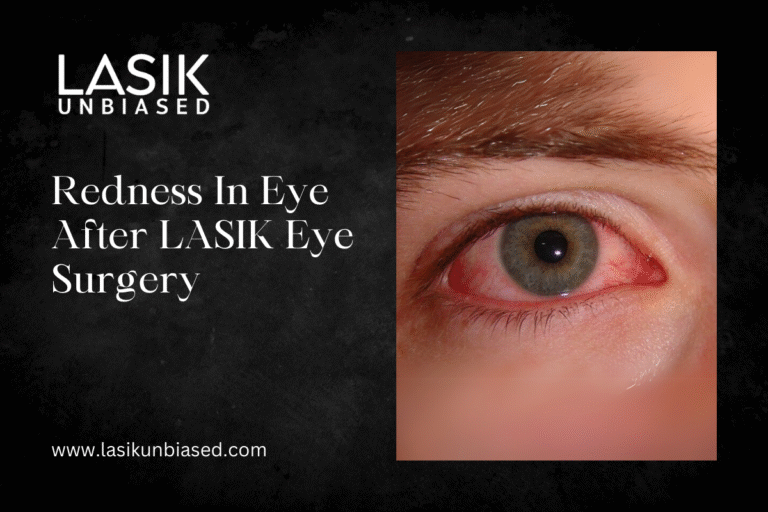Redness after LASIK is common and typically harmless. It usually clears up on its own in a few days, but knowing the causes and signs can help you manage it better.
LASIK eye surgery has become a go-to solution for vision correction, offering patients a chance to bid farewell to glasses and contact lenses. However, like any surgical procedure, it comes with its post-operative quirks – one being redness. This blog aims to explore why redness may appear, when it’s normal, and when to seek medical advice.
What Causes Redness in the Eye After LASIK?
1. Suction Ring During Surgery
One reason for post-LASIK redness is the suction ring used during the procedure. The suction ring provides stability to the eye during the creation of the corneal flap. While crucial for precision, it temporarily affects the blood vessels, causing red spots or patches on the eye.
These spots, known as subconjunctival haemorrhages, look alarming but are usually painless and harmless. They fade naturally within one to two weeks as your eye heals.
2. Inflammation Post Surgery
Mild inflammation can occur after LASIK, and in some cases, a specific complication called diffuse lamellar keratitis (DLK), also known as “sands of the Sahara,” may develop. After LASIK, your cornea’s cells enter healing mode, resulting in temporary swelling. The accompanying redness may last for a few days and generally resolves with prescribed anti-inflammatory eye drops.
Additionally, your cornea undergoes changes during LASIK. This may irritate small blood vessels, causing visible redness.
3. Straining the Eyes Post-Surgery
Lasers may correct your vision, but your eyes will still require rest and care. Straining your eyes by prolonged screen use or visual tasks can increase dryness and discomfort, which may contribute to visible redness. Overexertion delays healing, making redness more noticeable.
4. Dry Eyes
LASIK can cause temporary changes in tear production, leaving your eyes dry and red. Since the nerves responsible for tear stimulation are affected during the surgery, dry eye syndrome is common post-LASIK. This dryness may contribute to visible redness, a sensation of itching, or discomfort. Lubricating eye drops, as recommended by your ophthalmologist, can relieve symptoms.
How Long Should Post-LASIK Redness Last?
Typical Recovery Timeline
For most patients, mild redness resolves within 48 hours to a week. Subconjunctival haemorrhages, identified by small red blood patches, can last longer, often clearing within two weeks.
Your healing time depends on numerous factors, including adherence to post-operative care guidelines and individual healing responses. Make sure to attend follow-up visits to monitor your progress.
Factors That May Prolong Redness
- Rubbing Your Eyes: Avoid rubbing or touching your eyes post-procedure to prevent irritation.
- Skipping Eye Drops: Missing your doses of anti-inflammatory or lubricating drops may exacerbate redness and slow healing.
- Ignoring Sensitive Triggers: Excessive screen time or exposure to harsh lights can irritate eyes further, prolonging redness.
When is Redness a Sign of a Serious Issue?
1. Persistent Redness Beyond 2 Weeks
If your redness doesn’t subside after two weeks or worsens over time, it could indicate complications beyond typical healing responses.
2. Accompanied by Severe Pain or Vision Changes
Mild irritation is expected after LASIK, but if redness is combined with severe pain, blurred vision, sensitivity to light, or discharge, contact your doctor immediately. These symptoms may signal conditions like infection or corneal issues requiring prompt attention.
3. Recurring Redness Days After Subduing
A resurgence of redness after initial improvement may hint at complications such as inflammation or dislocation of the corneal flap. It’s critical to consult your eye surgeon in such cases.
Tips to Minimise and Manage Redness After LASIK
1. Follow Your Doctor’s Instructions
Ensure the timely use of all prescribed medications, including antibiotics and anti-inflammatory eye drops. These help prevent infection, manage inflammation, and reduce redness.
2. Prioritise Rest and Recovery
Allow your eyes adequate downtime. Resting reduces strain and facilitates full recovery. Avoid engaging in visually demanding activities such as typing, driving, or screen usage immediately after surgery.
3. Keep Your Eyes Moisturised
Lubricate your eyes meticulously as instructed by your ophthalmologist. Include rewetting eye drops and artificial tears in your recovery routine to counter dryness and minimise redness.
4. Protect Your Eyes from Irritants
- Avoid dust, smoke, or harsh winds, as these can aggravate sensitivity and redness.
- Wear the eye shields or sunglasses provided by your surgeon to protect your eyes during healing.
5. Stay Hydrated and Eat Well
Your overall health significantly influences your recovery process. Drink plenty of water and consume foods rich in omega-3 fatty acids to manage dryness and promote faster healing.
Myths About Redness After LASIK
1. Red Eyes Mean the Surgery Went Wrong
Not necessarily. Mild redness is a normal physiological response to surgery. It indicates your body is healing, not that something went wrong.
2. Rubbing Eyes Post-Surgery is Safe
It is not advisable to rub your eyes after LASIK surgery, as this may disrupt the healing of the corneal flap and increase the risk of complications. Please adhere to your surgeon’s post-operative instructions to prevent strain or pressure on your eyes.
3. Any Redness Requires Immediate Concern
While monitoring redness is important, not all types require an alarm. Recognise the distinction between common, temporary redness and symptoms that demand medical attention.
When to Call Your Eye Doctor?
Please contact your ophthalmologist immediately in the following scenarios:
- Worsening Redness coupled with pain or vision issues.
- Sticky or yellow discharge, which could indicate infection.
- Sensitivity to light persists despite using protective gear.
Timely consultation ensures your concerns are addressed and healing stays on track.
Post-Surgery Changes Are Normal
Redness after LASIK is usually nothing to worry about, signifying your eyes are recovering. However, being aware of what’s normal and what’s not can enhance your post-operative experience. Following the aftercare provided by your ophthalmologist, coupled with personal efforts to rest and protect your eyes, is the best way to ensure a smooth recovery.
If you’re wondering whether LASIK is right for you or have concerns about aftercare, reach out to a qualified eye surgeon for guidance. Your vision deserves nothing less than expert attention.


